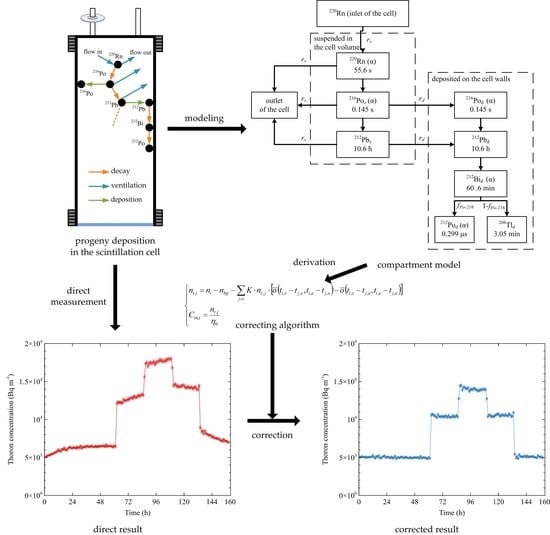Thoron Gas Measurement Using Airflow-Through Scintillation Cell with Consideration of Progeny Deposition
Abstract
1. Introduction
2. Materials and Methods
2.1. Compartment Model
2.2. Calibration Procedure
2.3. Algorithm for Correcting Progeny Accumulation Effect and Estimating Thoron Concentration
2.4. Laboratory Validation and Test
2.5. Evaluation of Lower Detection Limit and Measurement Uncertainty
3. Results
3.1. Calibration Results of the Scintillation Cell
3.2. Validation of the Compartment Model Using PIPS Detector
3.3. Laboratory Test Results
3.4. Comparison on Lower Detection Limit and Measurement Uncertainty
4. Discussion
5. Conclusions
6. Patents
Author Contributions
Funding
Institutional Review Board Statement
Informed Consent Statement
Data Availability Statement
Acknowledgments
Conflicts of Interest
References
- United Nations Scientific Committee on the Effects of Atomic Radiation. Report of the United Nations Scientific Committee on the Effects of Atomic Radiation to the General Assembly: ANNEX B Exposures from Natural Radiation Sources; United Nations Scientific Committee on the Effects of Atomic Radiation: New York, NY, USA, 2000; pp. 107–108, 112. [Google Scholar]
- Zeeb, H.; Shannoun, F. WHO Handbook on Indoor Radon: A Public Health Perspective; WHO Press: Geneva, Switzerland, 2009; p. 3. ISBN 978-92-4-154767-3. [Google Scholar]
- Tokonami, S. Characteristics of Thoron (220Rn) and Its Progeny in the Indoor Environment. Int. J. Environ. Res. Public. Health 2020, 17, 8769. [Google Scholar] [CrossRef] [PubMed]
- Tokonami, S. Why Is 220Rn (Thoron) Measurement Important? Radiat. Prot. Dosim. 2010, 141, 335–339. [Google Scholar] [CrossRef] [PubMed]
- Janik, M. Environmental Radioactivity Monitoring and Measurements: Radon and Thoron. Int. J. Environ. Res. Public. Health 2022, 19, 9276. [Google Scholar] [CrossRef]
- International Commission on Radiological Protection. Occupational Intakes of Radionuclides: Part 3. ICRP Publication 137; ICRP 46(3/4); ICRP: Ottawa, ON, Canada, 2017; p. 315. ISBN 978-1-5264-4016-7. [Google Scholar]
- Steinhäusler, F. Environmental 220Rn: A Review. Environ. Int. 1996, 22, 1111–1123. [Google Scholar] [CrossRef]
- Nuccetelli, C.; Bochicchio, F. The Thoron Issue: Monitoring Activities, Measuring Techniques and Dose Conversion Factors. Radiat. Prot. Dosim. 1998, 78, 59–64. [Google Scholar] [CrossRef]
- Shang, B.; Chen, B.; Gao, Y.; Wang, Y.; Cui, H.; Li, Z. Thoron Levels in Traditional Chinese Residential Dwellings. Radiat. Environ. Biophys. 2005, 44, 193–199. [Google Scholar] [CrossRef]
- Zunic, Z.S.; Stojanovska, Z.; Veselinovic, N.; Mishra, R.; Yarmoshenko, I.V.; Sapra, B.K.; Ishikawa, T.; Omori, Y.; Curguz, Z.; Bossew, P.; et al. Indoor Radon, Thoron and Their Progeny Concentrations in High Thoron Rural Serbia Environments. Radiat. Prot. Dosim. 2017, 177, 36–39. [Google Scholar] [CrossRef]
- Nyambura, C.; Tokonami, S.; Hashim, N.O.; Chege, M.W.; Suzuki, T.; Kudo, H.; Hosoda, M. Annual Effective Dose Assessment Due to Radon and Thoron Progenies in Dwellings of Kilimambogo, Kenya. Radiat. Prot. Dosim. 2019, 184, 430–434. [Google Scholar] [CrossRef]
- Sanada, T. Measurement of Indoor Thoron Gas Concentrations Using a Radon-Thoron Discriminative Passive Type Monitor: Nationwide Survey in Japan. Int. J. Environ. Res. Public. Health 2021, 18, 1299. [Google Scholar] [CrossRef]
- Chen, J. Assessment of Thoron Contribution to Indoor Radon Exposure in Canada. Radiat. Environ. Biophys. 2022, 61, 161–167. [Google Scholar] [CrossRef]
- Lucas, H.F. Improved Low-Level Alpha-Scintillation Counter for Radon. Rev. Sci. Instrum. 1957, 28, 680–683. [Google Scholar] [CrossRef]
- Hutter, A.R. A Method for Determining Soil Gas 220Rn (Thoron) Concentrations. Health Phys. 1995, 68, 835–839. [Google Scholar] [CrossRef] [PubMed]
- Tokonami, S.; Yang, M.; Yonehara, H.; Yamada, Y. Simple, Discriminative Measurement Technique for Radon and Thoron Concentrations with a Single Scintillation Cell. Rev. Sci. Instrum. 2002, 73, 69–72. [Google Scholar] [CrossRef]
- Eappen, K.P.; Nair, R.N.; Mayya, Y.S. Simultaneous Measurement of Radon and Thoron Using Lucas Scintillation Cell. Radiat. Meas. 2008, 43, 91–97. [Google Scholar] [CrossRef]
- Zhang, L.; Wu, J.; Guo, Q.; Zhuo, W. Measurement of Thoron Gas in the Environment Using a Lucas Scintillation Cell. J. Radiol. Prot. 2010, 30, 597–605. [Google Scholar] [CrossRef] [PubMed]
- Sumesh, C.G.; Kumar, A.V.; Nair, R.N.; Tripathi, R.M.; Puranik, V.D. Estimation of Thoron Concentration Using Scintillation Cell. Radiat. Prot. Dosim. 2012, 150, 536–540. [Google Scholar] [CrossRef]
- Zhao, C.; Zhuo, W.; Chen, B. An Optimal Measuring Timetable for Thoron Measurements by Using Lucas Scintillation Cell. Radiat. Prot. Dosim. 2012, 152, 125–129. [Google Scholar] [CrossRef]
- Giffin, C.; Kaufman, A.; Broecker, W. Delayed Coincidence Counter for the Assay of Actinon and Thoron. J. Geophys. Res. 1963, 68, 1749–1757. [Google Scholar] [CrossRef]
- Hashimoto, T.; Sakai, Y. Selective Determination of Extremely Low-Levels of the Thorium Series in Environmental Samples by a New Delayed Coincidence Method. J. Radioanal. Nucl. Chem. Artic. 1990, 138, 195–206. [Google Scholar] [CrossRef]
- Falk, R.; Moere, H.; Nyblom, L. Measuring Techniques for Environmental Levels of Radon-220 in Air Using Flow-through Lucas Cell and Multiple Time Analysis of Recorded Pulse Events. Appl. Radiat. Isot. 1992, 43, 111–118. [Google Scholar] [CrossRef]
- Iimoto, T.; Kurosawa, R. A Pulse-Coincidence 220Rn Monitor with Three Time-Gates. Environ. Int. 1996, 22, 1139–1145. [Google Scholar] [CrossRef]
- Irlinger, J.; Wielunski, M.; Rühm, W. Thoron Detection with an Active Radon Exposure Meter—First Results. Rev. Sci. Instrum. 2014, 85, 022106. [Google Scholar] [CrossRef] [PubMed]
- Qiu, S. Calibration of Thoron Monitors. Chin. J. Nucl. Tech. 2003, 26, 561–563. [Google Scholar]
- Tang, F.; Zhuo, W.; Zhao, C.; Chen, B.; Xu, Y.; He, L. A Theoretical Study on Accurate Measurements of Thoron with Airflow-through Scintillation Cell Method. Radiat. Prot. Dosim. 2010, 141, 448–451. [Google Scholar] [CrossRef] [PubMed]
- Sathyabama, N.; Datta, D.; Gaware, J.J.; Mayya, Y.S.; Tripathi, R.M. A Study of Disequilibrium between 220Rn and 216Po for 220Rn Measurements Using a Flow-through Lucas Scintillation Cell. Radiat. Prot. Dosim. 2014, 158, 187–194. [Google Scholar] [CrossRef] [PubMed]
- Eappen, K.P.; Sapra, B.K.; Mayya, Y.S. A Novel Methodology for Online Measurement of Thoron Using Lucas Scintillation Cell. Nucl. Instrum. Methods Phys. Res. Sect. Accel. Spectrometers Detect. Assoc. Equip. 2007, 572, 922–925. [Google Scholar] [CrossRef]
- Sumesh, C.G.; Ashokkumar, P.; Kumar, A.V.; Ratheesh, M.P.; Ravi, P.M.; Tripathi, R.M.; Mitra, A.K. Continuous Thoron Gas Measurement Using Single Scintillation Cell–Correction for 212Pb Deposition. Radiat. Meas. 2014, 67, 1–4. [Google Scholar] [CrossRef]
- Jacobi, W. Activity and Potential Alpha-Energy of 222Radon and 220Radon-Daughters in Different Air Atmospheres. Health Phys. 1972, 22, 441. [Google Scholar] [CrossRef]
- Porstendörfer, J.; Wicke, A.; Schraub, A. The Influence of Exhalation, Ventilation and Deposition Processes Upon the Concentration of Radon (222Rn), Thoron (220Rn) and Their Decay Products in Room Air. Health Phys. 1978, 34, 465–473. [Google Scholar] [CrossRef]
- Meisenberg, O.; Tschiersch, J. Specific Properties of a Model of Thoron and Its Decay Products in Indoor Atmospheres. Nukleonika 2010, 55, 463–469. [Google Scholar]
- Sakoda, A.; Meisenberg, O.; Tschiersch, J. Behavior of Radon Progeny Produced in a Scintillation Cell in the Flow-through Condition. Radiat. Meas. 2015, 77, 41–45. [Google Scholar] [CrossRef]
- Zhao, C.; Zhuo, W.; Chen, B.; Zhang, H. Characteristic and Performance of a Simple Thoron Chamber. Radiat. Prot. Dosim. 2010, 141, 444–447. [Google Scholar] [CrossRef] [PubMed]
- Zhao, C. Methods for the Calibration and Measurements of Thoron Concentrations. Doctoral Dissertation, Fudan University, Shanghai, China, 2014. [Google Scholar]
- Tang, F.; Zhuo, W.; He, L.; Zhao, C.; Xu, Y. Preparation and Emanation Properties of an Ion-Exchanged Solid Thoron Source. Radiat. Prot. Dosim. 2012, 152, 66–70. [Google Scholar] [CrossRef] [PubMed]
- Altshuler, B.; Pasternack, B. Statistical Measures of the Lower Limit of Detection of a Radioactivity Counter. Health Phys. 1963, 9, 293. [Google Scholar] [CrossRef] [PubMed]
- Herranz, M.; Idoeta, R.; Legarda, F. Evaluation of Uncertainty and Detection Limits in Radioactivity Measurements. Nucl. Instrum. Methods Phys. Res. Sect. Accel. Spectrometers Detect. Assoc. Equip. 2008, 595, 526–534. [Google Scholar] [CrossRef]
- Janik, M.; Tokonami, S.; Iwaoka, K.; Karunakara, N.; Trilochana, S.; Mohan, M.P.; Kumara, S.; Yashodhara, I.; Zhuo, W.; Zhao, C.; et al. Comparison of Radon and Thoron Concentration Measuring Systems Among Asian Countries. Int. J. Environ. Res. Public. Health 2019, 16, 5019. [Google Scholar] [CrossRef]
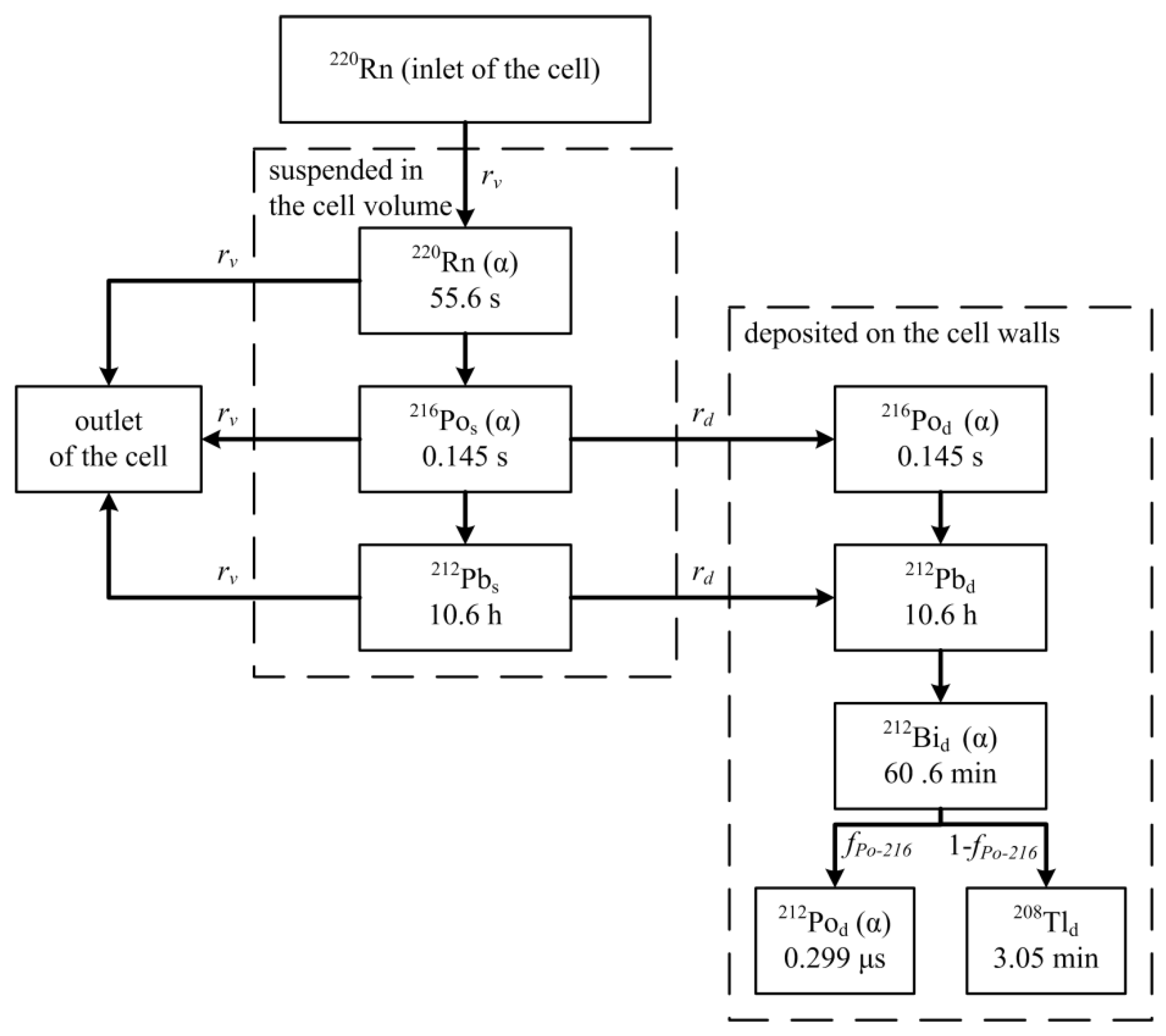
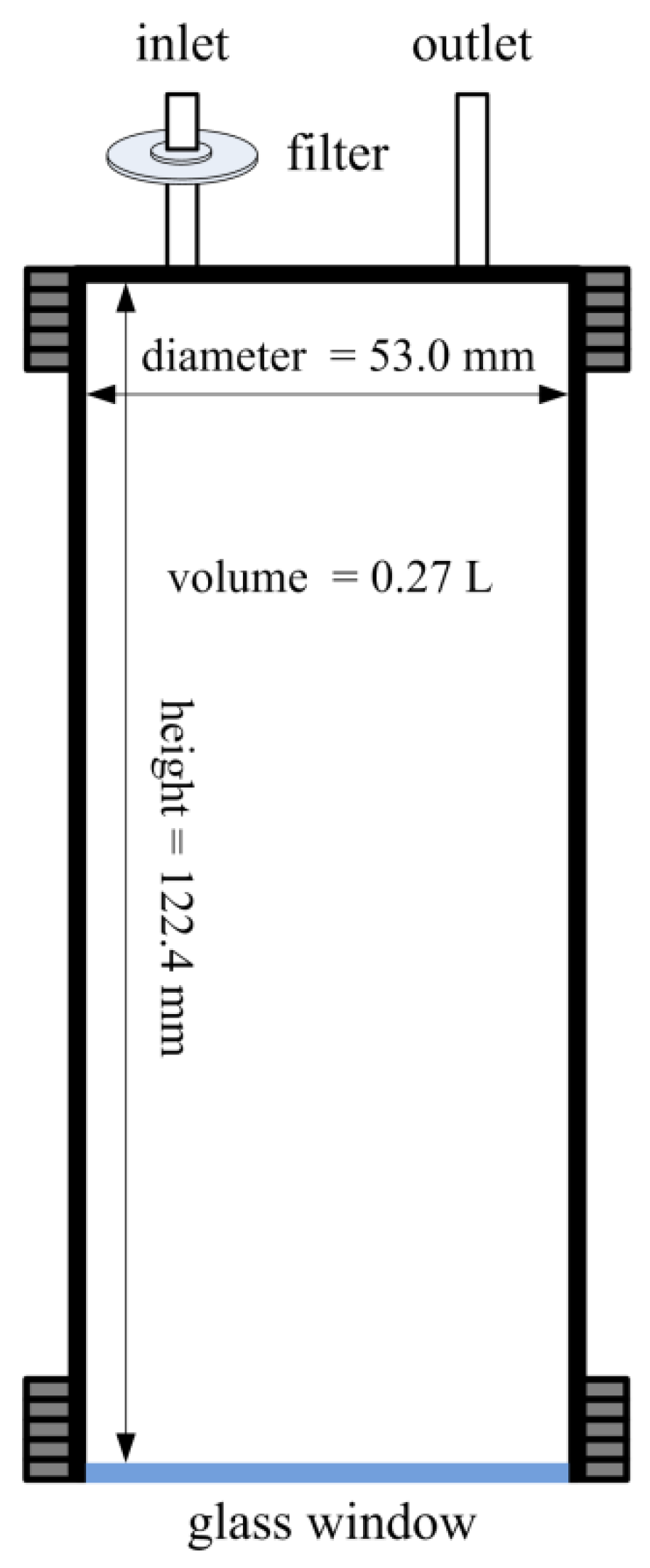
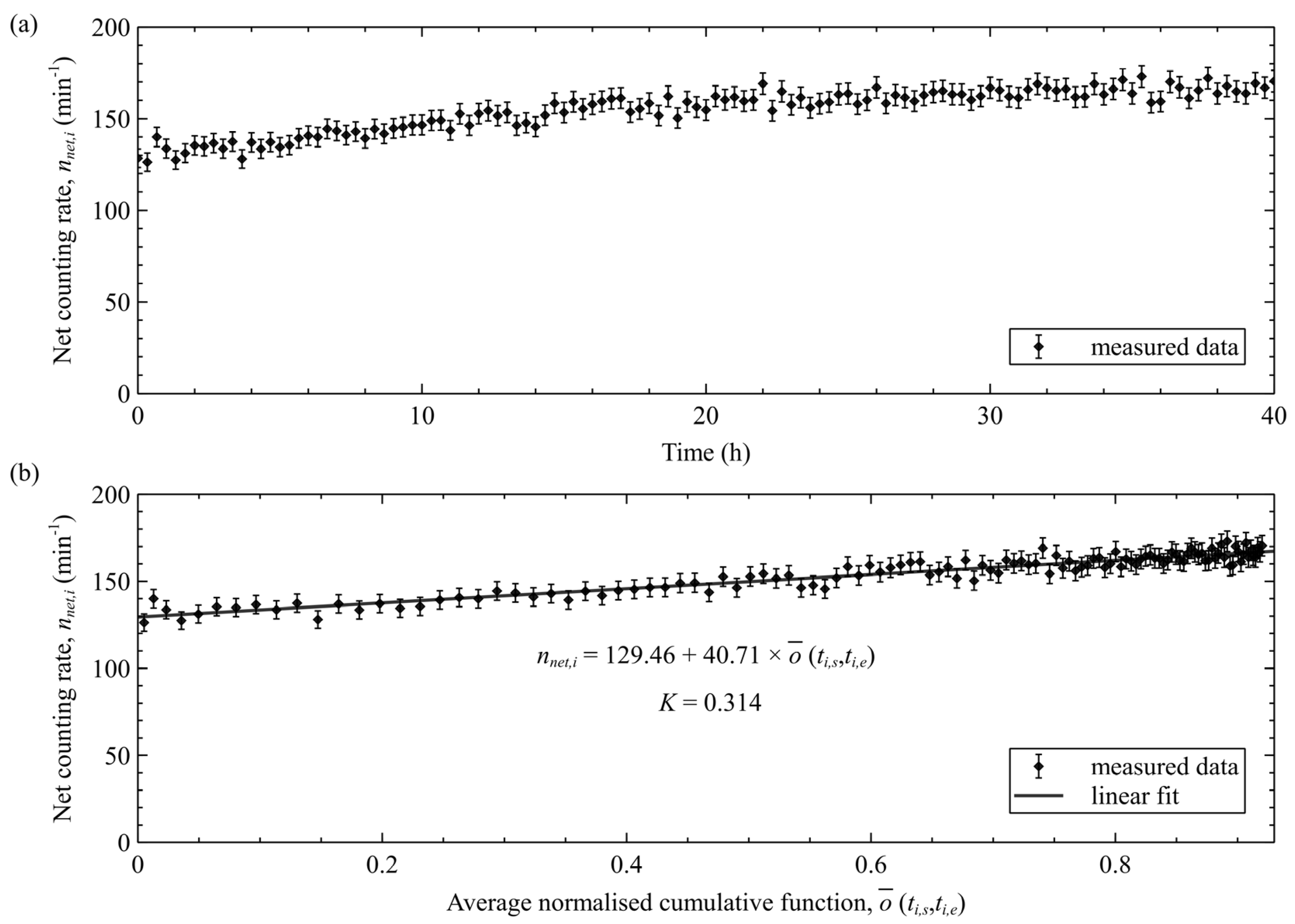
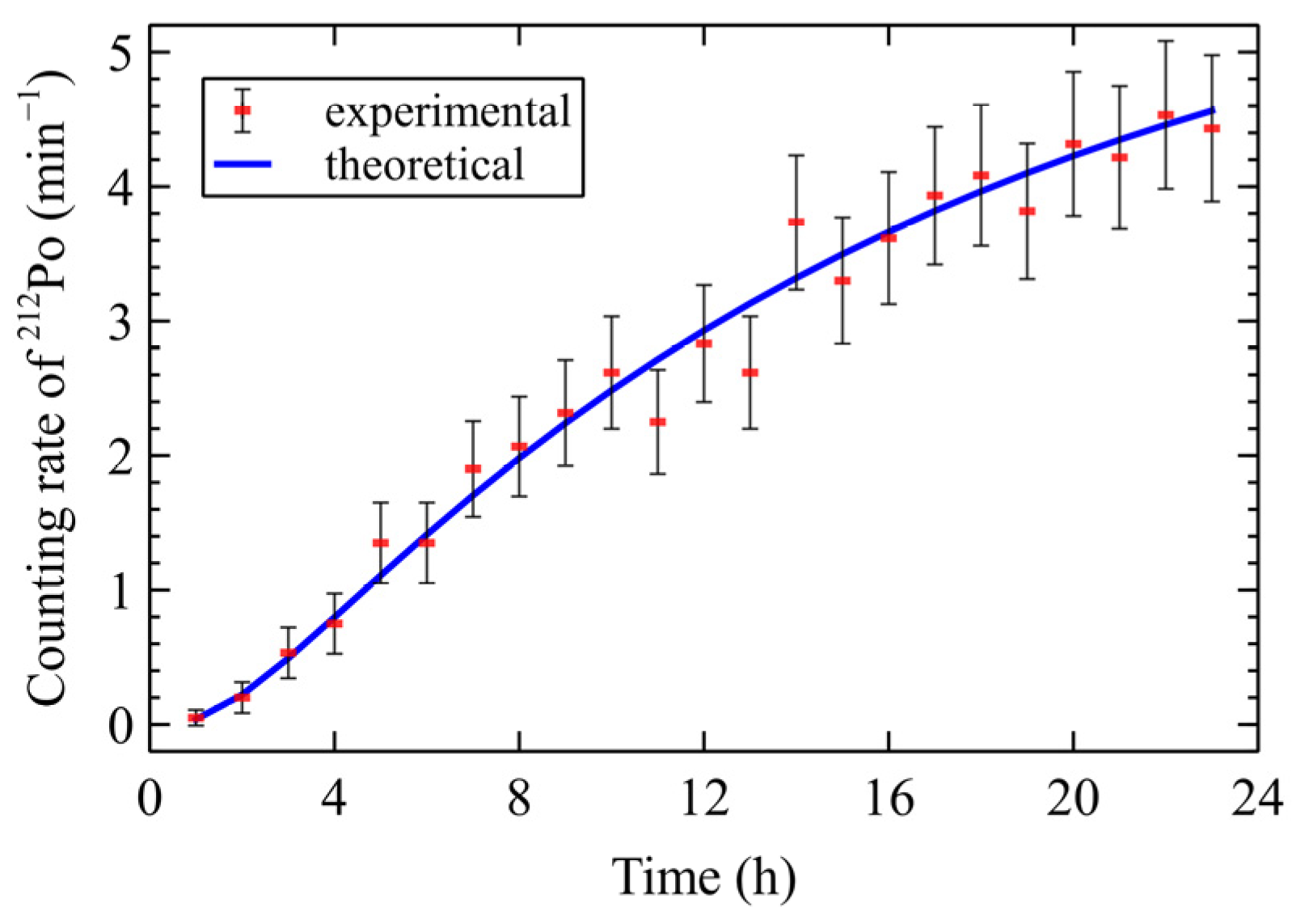
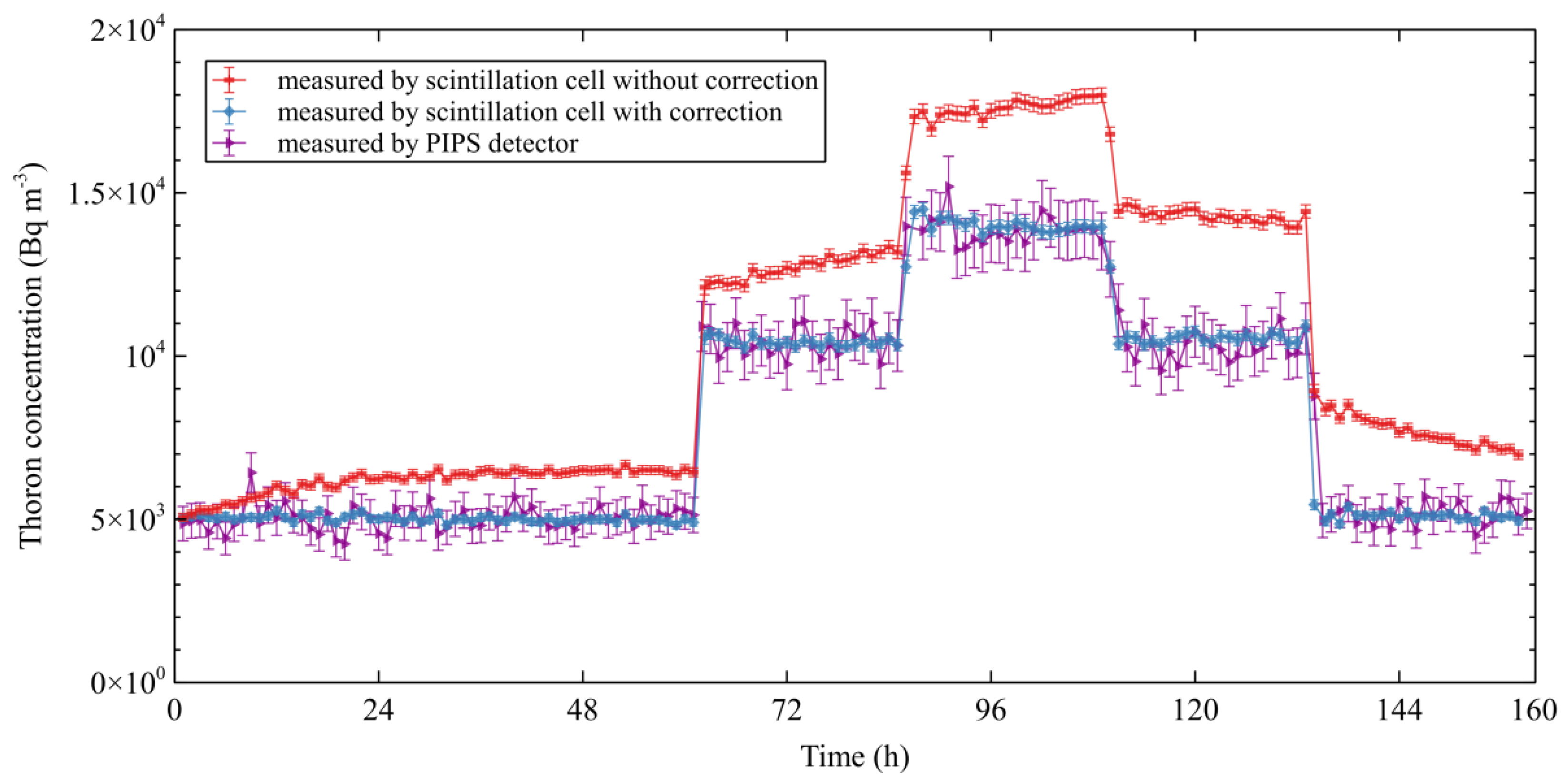
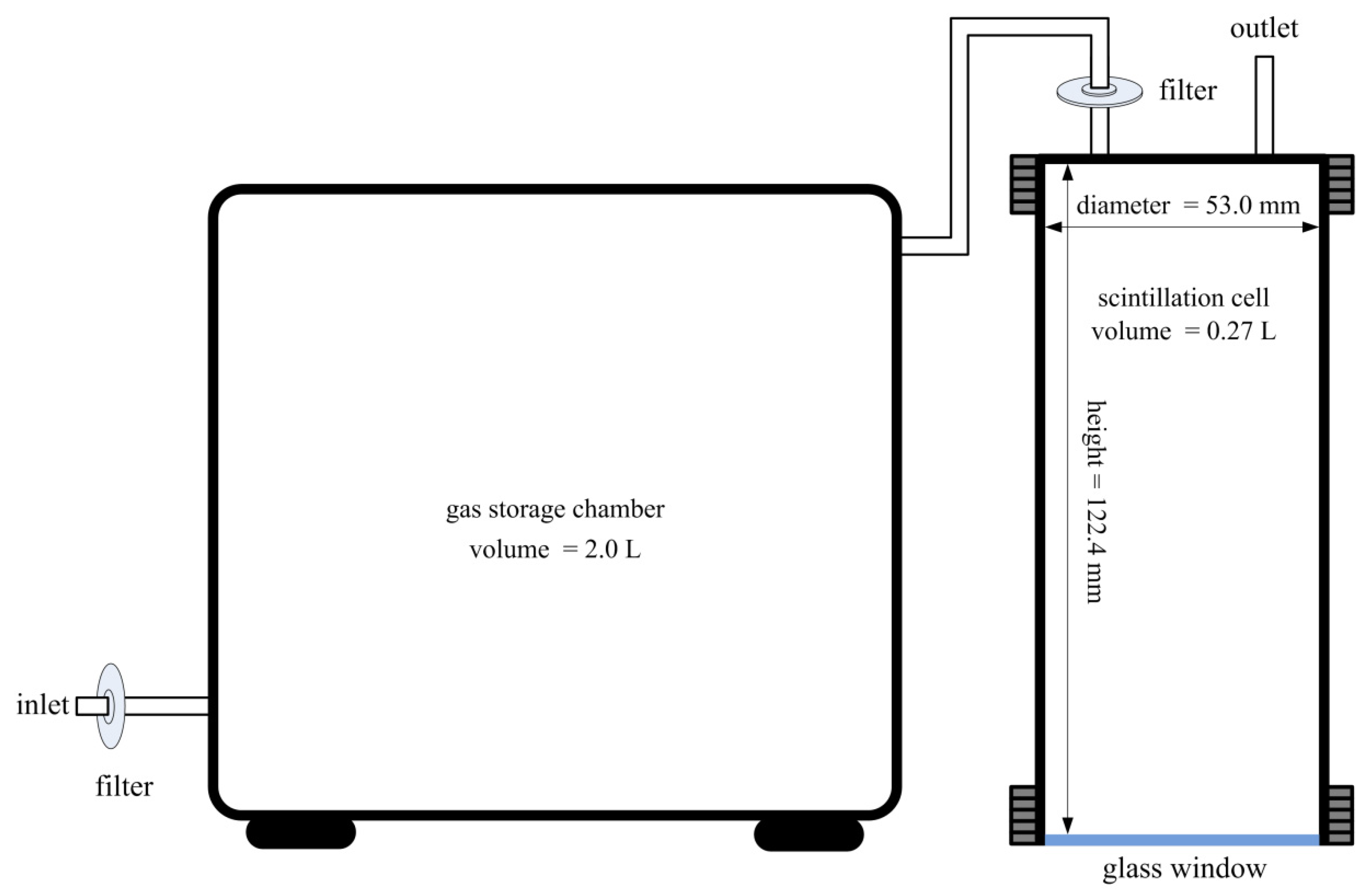
| Parameters | Airflow-Through Scintillation Cell | Grab-Sample Scintillation Cell | PIPS Device | |
|---|---|---|---|---|
| T = 1 min | T = 10 min | |||
| STn (min−1 (Bq m−3)−1) | 2.36 × 10−2 | 1.94 × 10−2 | 3.67 × 10−3 | 1.07 × 10−3 |
| SRn (min−1 (Bq m−3)−1) | 2.70 × 10−2 | 1.17 × 10−2 | 1.74 × 10−2 | 0.85 × 10−3 |
| nbg (min−1) | 1.02 | 1.02 | 1.02 | 1.67 × 10−3 |
| K * | 0.314 | / | / | / |
| Concentration of Radon (Bq m−3) | Airflow-Through Scintillation Cell | Grab-Sample Scintillation Cell | PIPS Device | |||
|---|---|---|---|---|---|---|
| T = 10 min | T = 60 min | T =1 min | T = 10 min | T = 10 min | T = 60 min | |
| 0 | 74 | 28 | 383 | 478 | 309 | 65 |
| 50 | 107 | 41 | 444 | 624 | 542 | 160 |
| 100 | 132 | 51 | 495 | 739 | 658 | 207 |
| 200 | 167 | 66 | 580 | 925 | 823 | 275 |
| 1000 | 341 | 137 | 996 | 1793 | 1522 | 560 |
| Concentration of Thoron (Bq m−3) | Concentration of Radon (Bq m−3) | Airflow-Through Scintillation Cell | Grab-Sample Scintillation Cell | PIPS Device | |||
|---|---|---|---|---|---|---|---|
| T = 10 min | T = 60 min | T =1 min | T = 10 min | T = 10 min | T = 60 min | ||
| 100 | 0 | 54% | 22% | / | / | / | 80% |
| 100 | 100 | / | 29% | / | / | / | / |
| 500 | 0 | 22% | 9% | 68% | 58% | 87% | 35% |
| 500 | 100 | 24% | 10% | 71% | / | / | 38% |
| 500 | 1000 | 35% | 14% | / | / | / | / |
| 1000 | 0 | 15% | 6% | 47% | 37% | 61% | 25% |
| 1000 | 50 | 15% | 6% | 47% | 41% | 62% | 25% |
| 1000 | 100 | 16% | 6% | 48% | 44% | 64% | 26% |
| 1000 | 1000 | 21% | 8% | 59% | / | / | 33% |
| 10,000 | 0 | 5% | 2% | 14% | 11% | 19% | 8% |
| 10,000 | 100 | 5% | 2% | 14% | 11% | 19% | 8% |
| 10,000 | 1000 | 5% | 2% | 15% | 13% | 20% | 8% |
| 10,000 | 10,000 | 6% | 3% | 18% | 25% | 26% | 11% |
Disclaimer/Publisher’s Note: The statements, opinions and data contained in all publications are solely those of the individual author(s) and contributor(s) and not of MDPI and/or the editor(s). MDPI and/or the editor(s) disclaim responsibility for any injury to people or property resulting from any ideas, methods, instructions or products referred to in the content. |
© 2023 by the authors. Licensee MDPI, Basel, Switzerland. This article is an open access article distributed under the terms and conditions of the Creative Commons Attribution (CC BY) license (https://creativecommons.org/licenses/by/4.0/).
Share and Cite
Zhao, C.; Liu, J.; Chen, Y.; He, L.; Tang, F.; Zhuo, W. Thoron Gas Measurement Using Airflow-Through Scintillation Cell with Consideration of Progeny Deposition. Atmosphere 2023, 14, 831. https://doi.org/10.3390/atmos14050831
Zhao C, Liu J, Chen Y, He L, Tang F, Zhuo W. Thoron Gas Measurement Using Airflow-Through Scintillation Cell with Consideration of Progeny Deposition. Atmosphere. 2023; 14(5):831. https://doi.org/10.3390/atmos14050831
Chicago/Turabian StyleZhao, Chao, Jiayu Liu, Yanliang Chen, Linfeng He, Fangdong Tang, and Weihai Zhuo. 2023. "Thoron Gas Measurement Using Airflow-Through Scintillation Cell with Consideration of Progeny Deposition" Atmosphere 14, no. 5: 831. https://doi.org/10.3390/atmos14050831
APA StyleZhao, C., Liu, J., Chen, Y., He, L., Tang, F., & Zhuo, W. (2023). Thoron Gas Measurement Using Airflow-Through Scintillation Cell with Consideration of Progeny Deposition. Atmosphere, 14(5), 831. https://doi.org/10.3390/atmos14050831





